Sanyo R410A User Manual
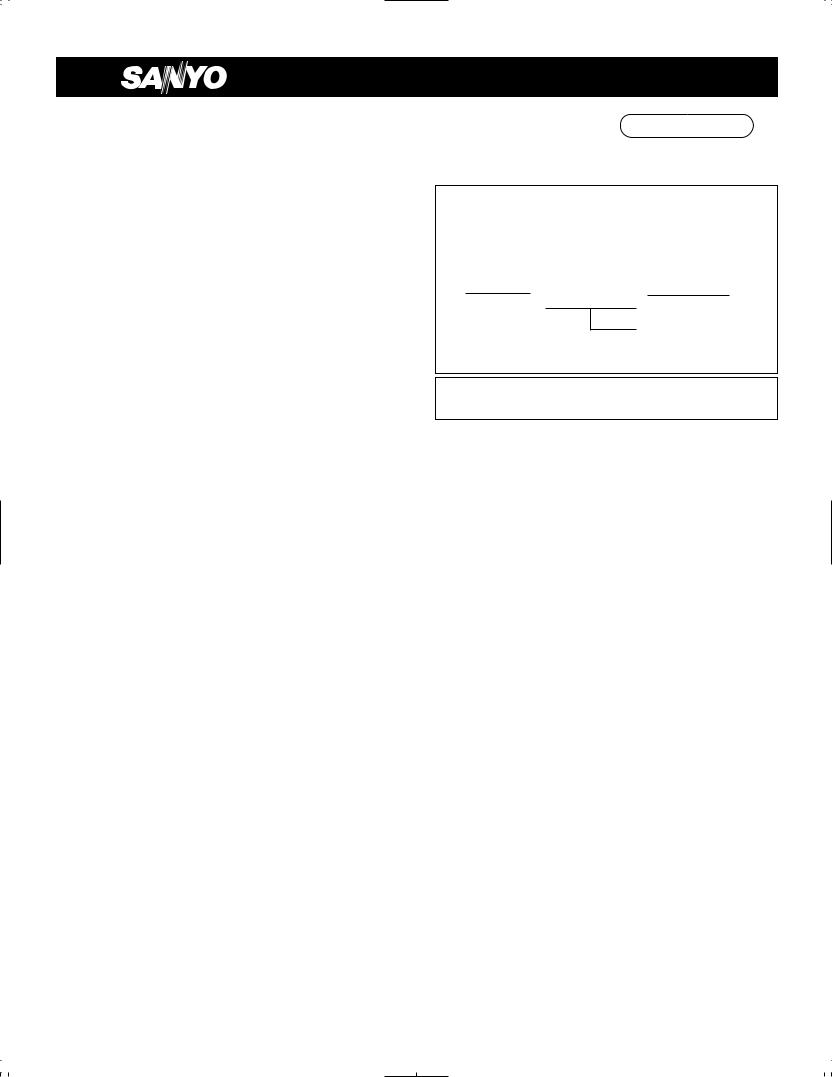
INSTALLATION INSTRUCTIONS
– Split System Air Conditioner –
COOL/DRY Model
In order to protect the environment, this air conditioner uses the new refrigerant R410A.
Contents
|
|
Page |
|
IMPORTANT! |
|
||
Please Read Before Starting .................................. |
1 |
||
1. |
GENERAL .......................................................... |
2 |
|
|
1-1. |
Tools Required for Installation (not supplied) |
|
|
1-2. |
Accessories Supplied with Indoor Unit |
|
|
1-3. |
Optional Copper Tubing Kit |
|
|
1-4. |
Type of Copper Tube and Insulation Material |
|
|
1-5. |
Field Wiring |
|
|
1-6. |
Additional Materials Required for Installation |
|
|
1-7. |
Operating Range |
|
2. |
INSTALLATION SITE SELECTION ................... |
3 |
|
|
2-1. |
Indoor Unit |
|
|
2-2. |
Outdoor Unit |
|
|
2-3. |
Air Discharge Chamber for Top Discharge |
|
|
2-4. |
Wind Shield for “CL” Model |
|
3. HOW TO INSTALL THE INDOOR UNIT ........... |
6 |
||
|
3-1. |
Remove the Rear Panel from the Unit |
|
|
3-2. |
Make a Hole |
|
|
3-3. |
Install the Rear Panel on the Wall |
|
|
3-4. |
Remove the Grille to Install the Indoor Unit |
|
|
3-5. |
Shape the Indoor Side Tubing |
|
|
3-6. |
Wiring Instructions |
|
|
3-7. |
Recommended Wire Length and Diameter |
|
|
3-8. |
Wiring Instructions for Inter-unit Connections |
|
|
3-9. |
Mounting |
|
|
3-10. |
Drain Hose |
|
4.REMOTE CONTROL UNIT INSTALLATION
|
POSITION ........................................................ |
14 |
|
|
4-1. |
Mounting on a Wall |
|
5. |
ADDRESS SWITCHES ..................................... |
15 |
|
6. |
HOW TO INSTALL THE OUTDOOR UNIT....... |
16 |
|
|
6-1. |
Removing the Packaging Skid |
|
|
6-2. |
Installing the Outdoor Unit |
|
|
6-3. |
Tubing Direction |
|
Model Combinations
Combine indoor and outdoor units only as listed below.
Indoor Unit |
Outdoor Units |
KS2462R |
C2462R |
|
CL2462R |
Power supply: 60Hz, single-phase, 208/230V
Units should be installed by a licensed contractor according to local code requirements.
7. ELECTRICAL WIRING ..................................... |
17 |
|
7-1. |
General Precautions on Wiring |
|
7-2. |
Recommended Wire Length and Wire |
|
|
Diameter for Power Supply System |
|
7-3. |
Wiring System Diagram |
|
7-4. |
Examples of Incorrect Wiring |
|
8. |
HOW TO PROCESS TUBING .......................... |
19 |
|
|
8-1. |
Use of the Flaring Method |
|
|
8-2. |
Flaring Procedure with a Flare Tool |
|
|
8-3. |
Caution before Connecting Tubes Tightly |
|
|
8-4. |
Precautions During Brazing |
|
|
8-5. |
Indoor Unit Tubing |
|
|
8-6. Connecting Tubing between Indoor and |
|
|
|
|
Outdoor Units |
|
|
8-7. Insulation of Refrigerant Tubing |
|
|
|
8-8. |
Taping the Tubes |
|
|
8-9. |
Finishing the Installation |
|
9. |
AIR PURGING................................................... |
22 |
|
10. |
TEST RUN......................................................... |
25 |
|
|
10-1. |
Preparing for Test Run |
|
|
10-2. |
Performing Test Run |
|
11. |
REFRIGERANT R410A: SPECIAL PRECAUTIONS |
||
|
WHEN INSTALLING UNIT................................ |
28 |
|
|
11-1. |
Characteristics of New Refrigerant R410A |
|
|
11-2. |
Checklist Before Installation |
|
|
11-3. |
Tools Specifically for R410A |
|
|
11-4. |
Charging Additional Refrigerant |
|
|
|
In Canada |
|
SANYO FISHER COMPANY |
SANYO Canada Inc. |
|
A DIVISION OF SANYO NORTH AMERICA CORPORATION |
300 Applewood Crescent |
|
21605 Plummer Street |
Concord, Ontario |
85464359328000 © SANYO 2002 |
Chatsworth, CA 91311 U.S.A. |
L4K 5C7, Canada |

IMPORTANT!
Please Read Before Starting
This air conditioning system meets strict safety and operating standards. As the installer or service person, it is an important part of your job to install or service the system so it operates safely and efficiently.
For safe installation and trouble-free operation, you must:
●Carefully read this instruction booklet before beginning.
●Follow each installation or repair step exactly as shown.
●Observe all local, state, and national electrical codes.
●Pay close attention to all warning and caution notices given in this manual.
This symbol refers to a hazard or WARNING unsafe practice which can result
in severe personal injury or death.
This symbol refers to a hazard CAUTION or unsafe practice which can
result in personal injury or product or property damage.
If Necessary, Get Help
These instructions are all you need for most installation sites and maintenance conditions. If you require help for a special problem, contact our sales/service outlet or your certified dealer for additional instructions.
In Case of Improper Installation
The manufacturer shall in no way be responsible for improper installation or maintenance service, including failure to follow the instructions in this document.
SPECIAL PRECAUTIONS
WARNING When Wiring
ELECTRICAL SHOCK CAN CAUSE SEVERE PERSONAL INJURY OR DEATH. ONLY A QUALIFIED, EXPERIENCED ELECTRICIAN SHOULD ATTEMPT TO WIRE THIS SYSTEM.
•Do not supply power to the unit until all wiring and tubing are completed or reconnected and checked.
•Highly dangerous electrical voltages are used in this system. Carefully refer to the wiring diagram and these instructions when wiring. Improper connections and inadequate grounding can cause accidental injury or death.
•Ground the unit following local electrical codes.
•Connect all wiring tightly. Loose wiring may cause overheating at connection points and a possible fire hazard.
When Transporting
Be careful when picking up and moving the indoor and outdoor units. Get a partner to help, and bend your knees when lifting to reduce strain on your back. Sharp edges or thin aluminum fins on the air conditioner can cut your fingers.
When Installing…
…In a Ceiling, Wall or Floor
Make sure the ceiling/wall/floor is strong enough to hold the unit’s weight. It may be necessary to construct a strong wood or metal frame to provide added support.
…In a Room
Properly insulate any tubing run inside a room to prevent “sweating” that can cause dripping and water damage to walls and floors.
…In Moist or Uneven Locations
Use a raised concrete pad or concrete blocks to provide a solid, level foundation for the outdoor unit. This prevents water damage and abnormal vibration.
…In an Area with High Winds
Securely anchor the outdoor unit down with bolts and a metal frame. Provide a suitable air baffle.
…In a Snowy Area (for Heat Pump-type Systems)
Install the outdoor unit on a raised platform that is higher than drifting snow. Provide snow vents.
When Connecting Refrigerant Tubing
•Use the flare method for connecting tubing.
•Apply refrigerant lubricant to the matching surfaces of the flare and union tubes before connecting them, then tighten the nut with a torque wrench for a leak-free connection.
•Check carefully for leaks before starting the test run.
When Servicing
•Turn the power OFF at the main power box (mains) before opening the unit to check or repair electrical parts and wiring.
•Keep your fingers and clothing away from any moving parts.
•Clean up the site after you finish, remembering to check that no metal scraps or bits of wiring have been left inside the unit being serviced.
Others
CAUTION
•Ventilate any enclosed areas when installing or testing the refrigeration system. Escaped refrigerant gas, on contact with fire or heat, can produce dangerously toxic gas.
•Confirm upon completing installation that no refrigerant gas is leaking. If escaped gas comes in contact with a stove, gas water heater, electric room heater or other heat source, it can produce dangerously toxic gas.
1
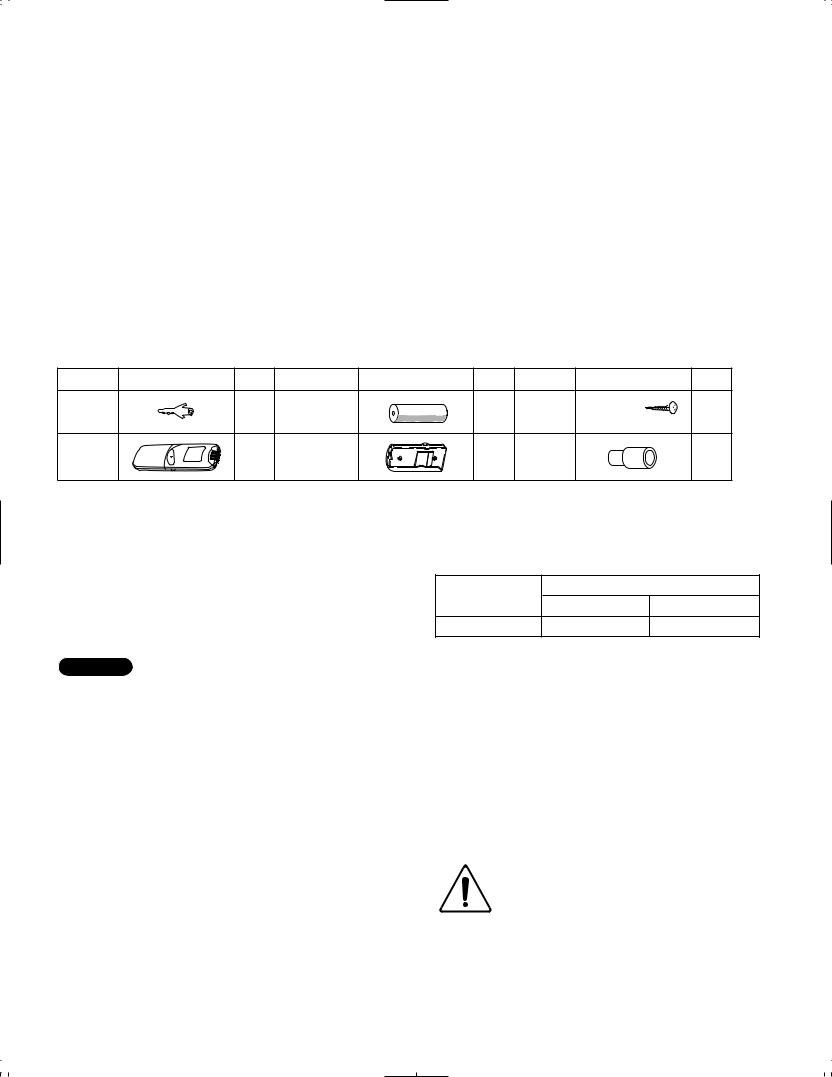
1. General
This booklet briefly outlines where and how to install the air conditioning system. Please read over the entire set of instructions for the indoor and outdoor units and make sure all accessory parts listed are with the system before beginning.
1-1. Tools Required for Installation (not supplied)
1.Standard screwdriver
2.Phillips head screwdriver
3.Knife or wire stripper
4.Tape measure
5.Carpenter’s level
6.Sabre saw or key hole saw
7.Hacksaw
8.Core bits
9.Hammer
10.Drill
11.Tube cutter
12.Tube flaring tool
13.Torque wrench
14.Adjustable wrench
15.Reamer (for deburring)
16.Pipe bending tool (spring bender)
1-2. Accessories Supplied with Indoor Unit Table 1
Parts |
Figure |
Q’ty |
Parts |
Figure |
Q’ty |
Parts |
|
|
Figure |
Q’ty |
Rawl plug |
|
12 |
AAA alkaline |
|
2 |
Tapping |
Truss-head |
12 |
||
|
|
Phillips |
||||||||
|
battery |
|
screw |
|||||||
|
|
|
|
|
5/32 |
× |
5/8" (4 × |
16 mm) |
||
|
|
|
|
|
|
|
||||
Remote |
|
1 |
Remote control |
|
1 |
Joint drain |
|
|
|
1 |
control unit |
|
holder |
|
|
|
|
||||
|
|
|
|
|
|
|
|
|
||
1-3. Optional Copper Tubing Kit
Copper tubing for connecting the outdoor unit to the indoor unit is available in kits which contain the narrow and wide tubing, fittings and insulation. Consult your nearest sales outlet or A/C workshop.
NOTE For rear-left tubing, optional tube connection (C) (APR-EN46U1B) is necessary. See
page 20.
Also consult your nearest sales outlet or A/C workshop.
1-4. Type of Copper Tube and Insulation Material
If you wish to purchase these materials separately from a local source, you will need:
1.Deoxidized annealed copper tube for refrigerant tubing as detailed in Table 2.
When cutting tubing, add approximately 12 to 16 in. to each tube length to reduce vibration between the air conditioning units.
Table 2
Model |
Outer Diameter |
||
Narrow Tube |
Wide Tube |
||
|
|||
KS2462R |
3/8" |
3/4" |
|
2.Foamed polyethylene insulation for the specified copper tubes as required to precise length of tubing. Wall thickness of the insulation should be not less than 5/16".
1-5. Field Wiring
Use insulated copper wire for field wiring. Wire size varies with the total length of wiring. Refer to 3-6. Wiring Instructions for details.
CAUTION |
Check local electrical codes |
|
and regulations before obtain- |
||
|
||
|
||
|
ing wire. Also, check any spec- |
|
|
ified instructions or limitations. |
2
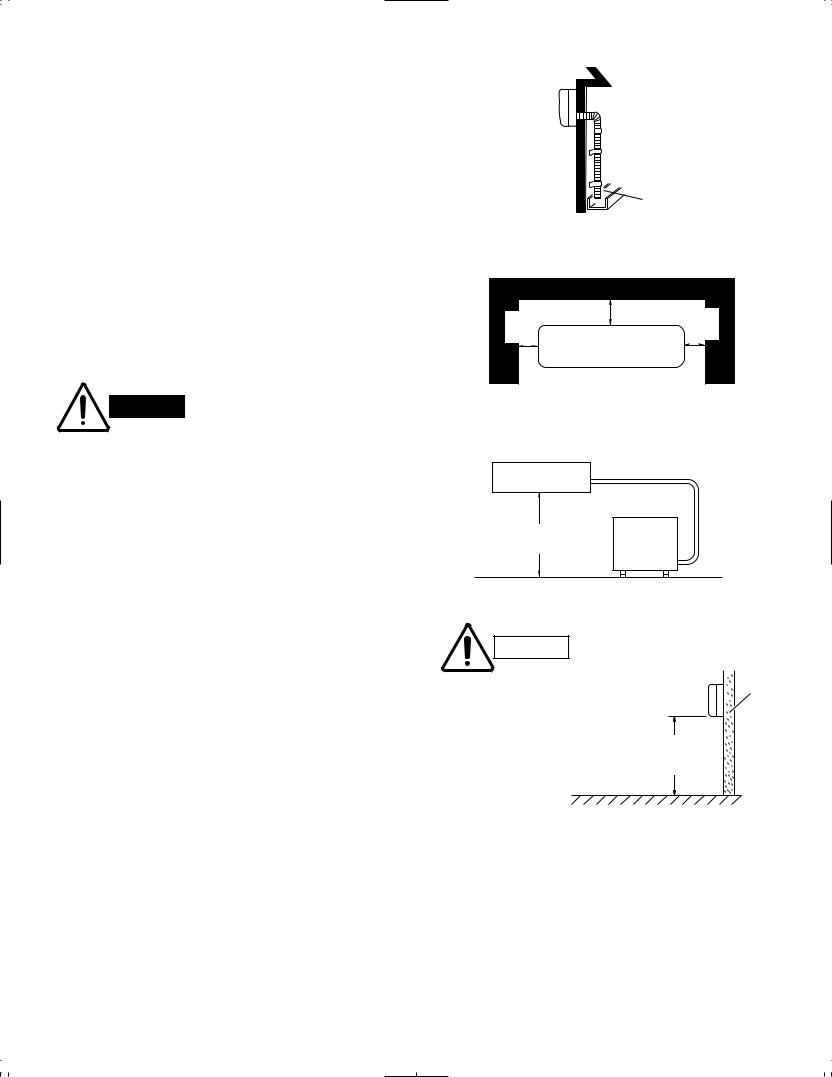
1-6. Additional Materials Required for Installation
1.Refrigeration (armored) tape
2.Insulated staples or clamps for connecting wire (See local codes)
3.Putty
4.Refrigeration lubricant
5.Clamps or saddles to secure refrigerant tubing
1-7. Operating Range
|
Temperature |
Indoor Air Intake |
Outdoor Air Intake |
|
|
Cooling |
Maximum |
95°F DB, 71°F WB |
115°F DB |
|
|
Minimum |
67°F DB, 57°F WB |
67°F DB, (0°F DB)* |
|
||
|
|
||||
|
|
|
*CL |
Models |
|
2. Installation Site Selection
2-1. Indoor Unit
To prevent abnormal heat genera- WARNING tion and the possibility of fire, do
not place obstacles, enclosures and grilles in front of or surrounding the air conditioner in a way that may block air flow.
AVOID:
●direct sunlight.
●nearby heat sources that may affect performance of the unit.
●areas where leakage of flammable gas may be expected.
●places where large amounts of oil mist exist.
DO:
●select an appropriate position from which every corner of the room can be uniformly cooled. (High on a wall is best.)
●select a location that will hold the weight of the unit.
●select a location where tubing and drain hose have the shortest run to the outside. (Fig. 1)
●allow room for operation and maintenance as well as unrestricted air flow around the unit. (Fig. 2)
●install the unit within the maximum elevation difference
(H) above or below the outdoor unit and within a total tubing length (L) from the outdoor unit as detailed in Table 3 and Fig. 3a.
Table 3
Indoor unit
 Drain hose
Drain hose
Outside drainage
Fig. 1
6 in. |
6 in. min. |
6 in. |
|
min. |
min. |
|
Front View |
|
Fig. 2 |
INDOOR |
Tubing length (L) |
UNIT |
|
Elevation difference (H)
OUTDOOR
UNIT
Fig. 3a
CAUTION
For stable operation of the air conditioner, do not install wall-mounted type indoor units less than 5 ft. from floor level.
Indoor unit
Wall
Minimum height from floor level
5 ft.
Floor level
Fig. 3b
|
Max. Allowable Tubing |
Limit of Tubing |
Limit of Elevation |
Required Amount of |
Model |
Length at Shipment |
Length (L) |
Difference (H) |
Additional Refrigerant |
|
(ft.) |
(ft.) |
(ft.) |
(oz./ft.)* |
|
|
|
|
|
C2462R, CL2462R |
23 |
132 |
50 |
0.43 |
|
|
|
|
|
*If total tubing length becomes 23 to 132 ft. (max.), additional refrigerant (R410A) charge of 0.43 oz./ft. is required.
No additional charge of compressor oil is necessary.
3
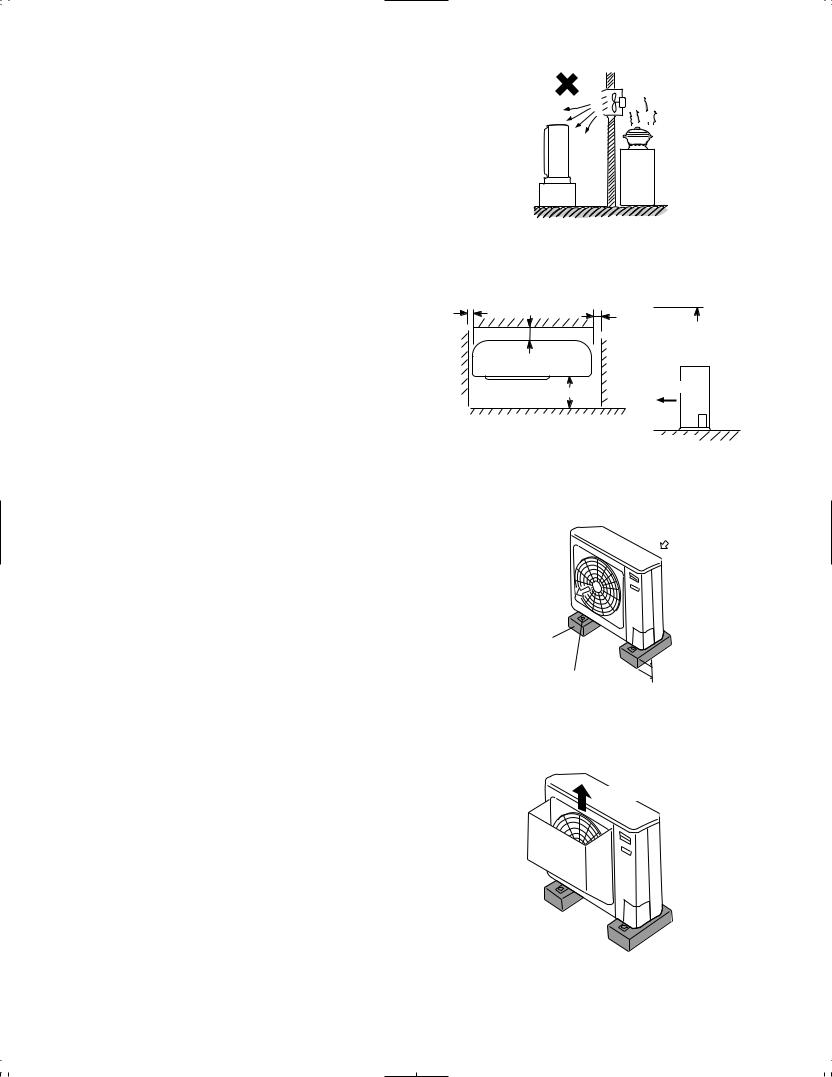
2-2. Outdoor Unit
AVOID:
●heat sources, exhaust fans, etc. (Fig. 4a)
●damp, humid or uneven locations.
DO:
●choose a place as cool as possible.
●choose a place that is well ventilated.
●allow enough room around the unit for air intake/ exhaust and possible maintenance. (Fig. 4b)
●provide a solid base a minimum of 6 inches above ground level to reduce humidity and protect the unit against possible water damage and decreased service life. (Fig. 4c)
●use lug bolts or equal to bolt down unit, to reduce vibration and noise.
2-3. Air Discharge Chamber for Top Discharge
Install the air-discharge chamber in the field when:
●it is difficult to keep a space of minimum 2 ft. between the air-discharge outlet and an obstacle.
●the air-discharge outlet faces a sidewalk and discharged hot air may disturb people passing by. Refer to Fig. 5a.
Exhaust fan
Hot air
Heat source
Outdoor unit
Fig. 4a
Min. 1 in.
Min. 1 in.
Min. 4 inches
Min. 2 ft.
Fig. 4b
Air in 
Air discharge
Concrete block 4 in. × 1 ft. 4 in. beams or equal
Anchor bolts (4 pieces)
Fig. 4c
Obstacle above
Min. 7 ft.
Air  discharge
discharge
Ground
Air in
Min. 6 in.
Air discharge
Fig. 5a
4

2-4. Wind Shield for “CL” Model
IMPORTANT
It is recommended to use wind shields for “CL” model (Fig. 5b). “CL” model is designed to use in low outdoor temperature conditions.
General
When the outdoor unit is installed in a position exposed to strong wind (like seasonal winds with low air temperature in winter), a suitable wind shield must be installed on the outdoor unit.
This unit is designed so that the fan of the outdoor unit runs at low speed when the air conditioner is operated at low outdoor air temperatures. When the outdoor unit is exposed to strong wind, the system pressure drops because of the freeze protector.
For outer dimensions of the wind shield, see Fig. 5c.
Wind shield
(air discharge side)
Front 
Fig. 5b
Recommended outer dimensions of wind shield (field supply)
|
-9/16" |
hole |
|
||
|
|
|
|
||
1 |
|
|
|
|
|
φ |
|
|
|
|
|
- |
|
|
|
|
|
3 |
|
|
|
|
|
|
9-27/32" |
|
|
|
|
21-13/16" |
|
|
|
hole |
|
|
|
|
|
|
|
φ15/64" |
|
|
|||
- |
|
|
|
|
|
6 |
|
|
|
|
|
|
21-5/8" |
22-7/16" |
|
23-15/32" |
5-3/16" |
1-1/16" |
9-27/32" |
9-27/32" |
15/16" |
1/2" |
5-5/32" |
|
|
||||
|
21-13/16" |
|
|
|
|
CL2462R
Fig. 5c
5
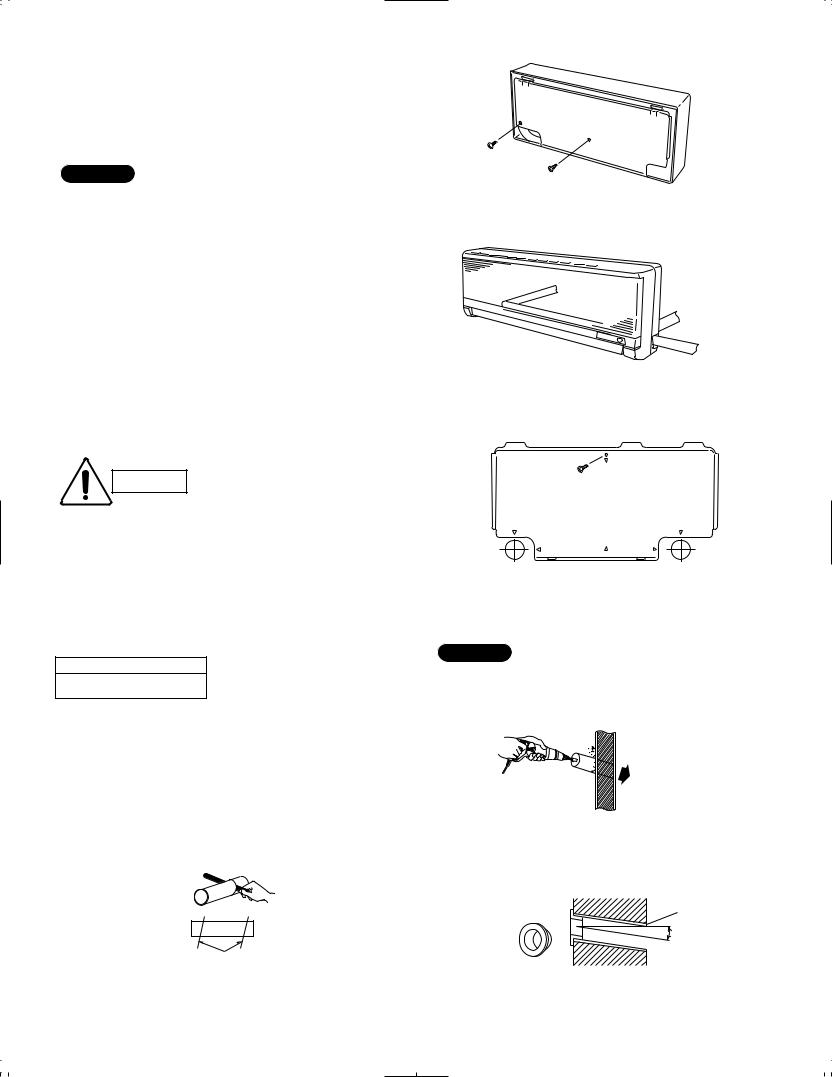
3. How to Install the Indoor Unit
3-1. Remove the Rear Panel from the Unit
Remove and discard the set screws and take off the rear panel. (Fig. 6)
NOTE
Tubing can be extended in 3 directions as shown in Fig. 7a. Select the direction you need providing the shortest run to the outside unit.
3-2. Make a Hole
(1)Remove the rear panel from the indoor unit and place it on the wall at the location selected. Make sure the unit is horizontal, using a carpenter’s level or tape measure to measure down from the ceiling.
(2)Determine which side of the unit you should make the hole. (Fig. 7b)
(3)Before making a hole, check carefully that no studs or pipes are directly run behind the spot to be cut.
CAUTION |
Also avoid areas where electri- |
|
cal wiring or conduits are |
||
|
||
|
located. |
The above precautions are also applicable if tubing goes through the wall in any other location.
(4)Using a sabre saw, key hole saw or hole-cutting drill attachment, cut a hole in the wall. See Table 4 and Fig. 8.
Table 4
Hole Dia. (inch)
3-3/16"
(5)Measure the thickness of the wall from the inside edge to the outside edge and cut PVC pipe at a slight angle 1/4" shorter than the thickness of the wall. (Fig. 9)
(6)Place the plastic cover over the end of the pipe (for indoor side only) and insert in the wall. (Fig. 10)
PVC pipe (locally purchased)
Cut at slight angle
Fig. 9
Set screws for transportation only
|
Fig. 6 |
Left-rear tubling |
Right-rear |
|
tubing |
|
(recommended) |
Right tubing
Fig. 7a
In case of left-rear or right-rear tubing
Center of |
Center of |
left-rear |
right-rear |
tubing hole |
tubing hole |
Fig. 7b
NOTE
Hole should be made at a slight downward slant to the outdoor side.
Indoor Outdoor side side
|
Fig. 8 |
|
INSIDE |
OUTSIDE |
|
Plastic cover |
Wall |
|
PVC pipe |
||
(Field supply) |
||
|
||
|
Slight |
|
|
angle |
Fig. 10
6
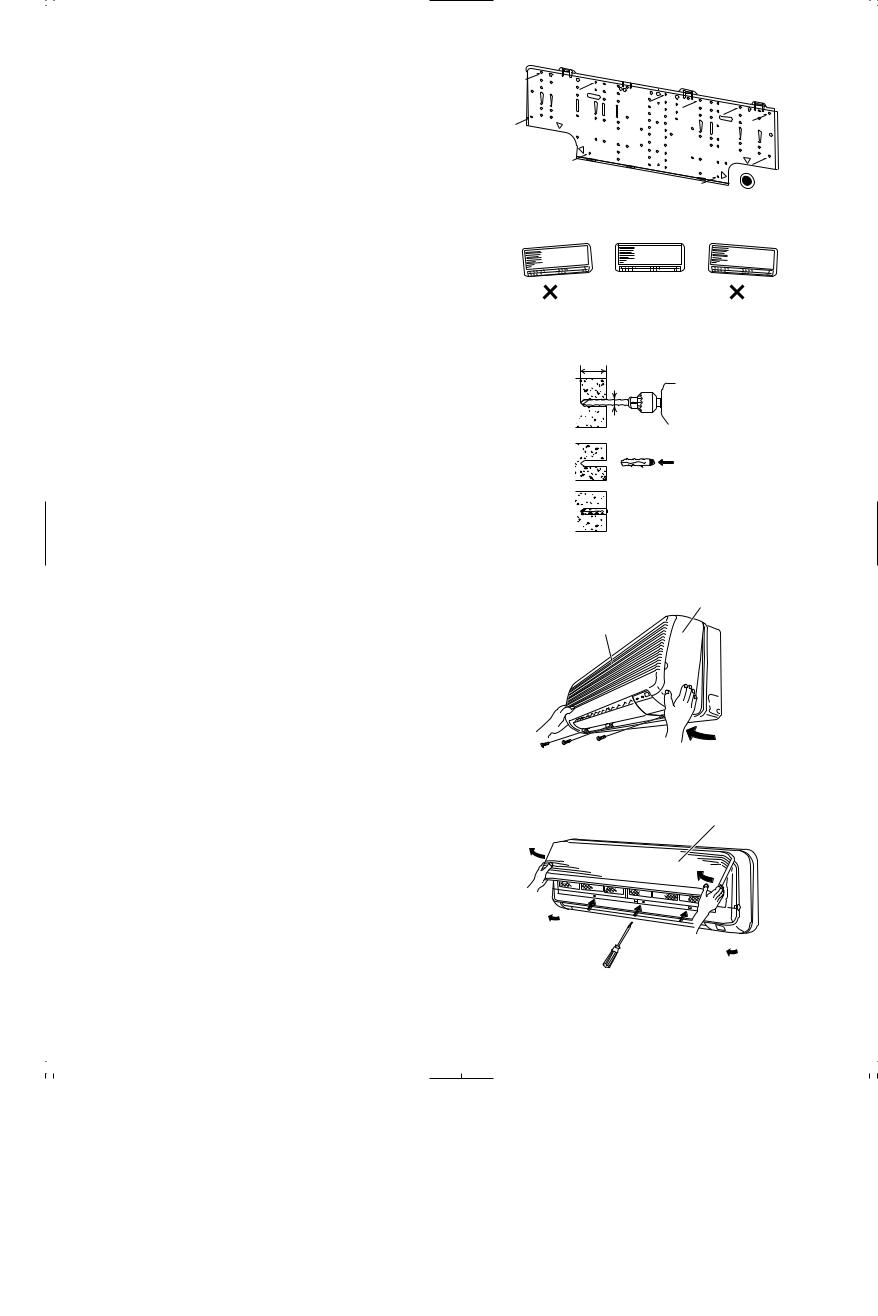
3-3. Install the Rear Panel on the Wall
Be sure to confirm that the wall is strong enough to suspend the unit.
See either Item a) or b) below depending on the wall type.
a) If Wooden Wall
(1)Attach the rear panel to the wall with the 10 screws provided. (Fig. 11)
If you are not able to line up the holes in the rear panel with the beam locations marked on the wall, use toggle bolts to go through the holes on the panel or drill 3/16" dia. holes in the panel over the stud locations and then mount the rear panel.
(2)Double check with a ruler or carpenter’s level that the panel is level. This is important to install the unit properly. (Fig. 12)
(3)Make sure the panel is flush against the wall. Any space between the wall and unit will cause noise and vibration.
b) If Block, Brick, Concrete or Similar Type Wall
Make 3/16" dia. holes in the wall. Insert rawl plugs for appropriate mounting screws. (Fig. 13)
3-4. Remove the Grille to Install the Indoor Unit
Basically, these models can be installed and wired without removing the grille. If access to any internal part is needed, follow the steps as given below:
How to remove the grille
(1)Set the 2 flaps in the horizontal position.
(2)Unscrew the 3 screws. (Fig. 14a)
(3)Remove the grille.
(a)Hold both corners of the air intake grille, then pull out and up to open. (Fig. 14b)
(b)Use a standard screwdriver to push up the 3 tabs to remove the grille. (Fig. 14b)
(c)Pull the lower part of the grille toward you to remove. (Fig. 14a)
Fig. 11
Fig. 12
1-3/16" or more
3/16" dia. hole
Rawl plug (Field supply)
Fig. 13
Grille
Air intake grille
Fig. 14a
Air intake grille
Fig. 14b
7
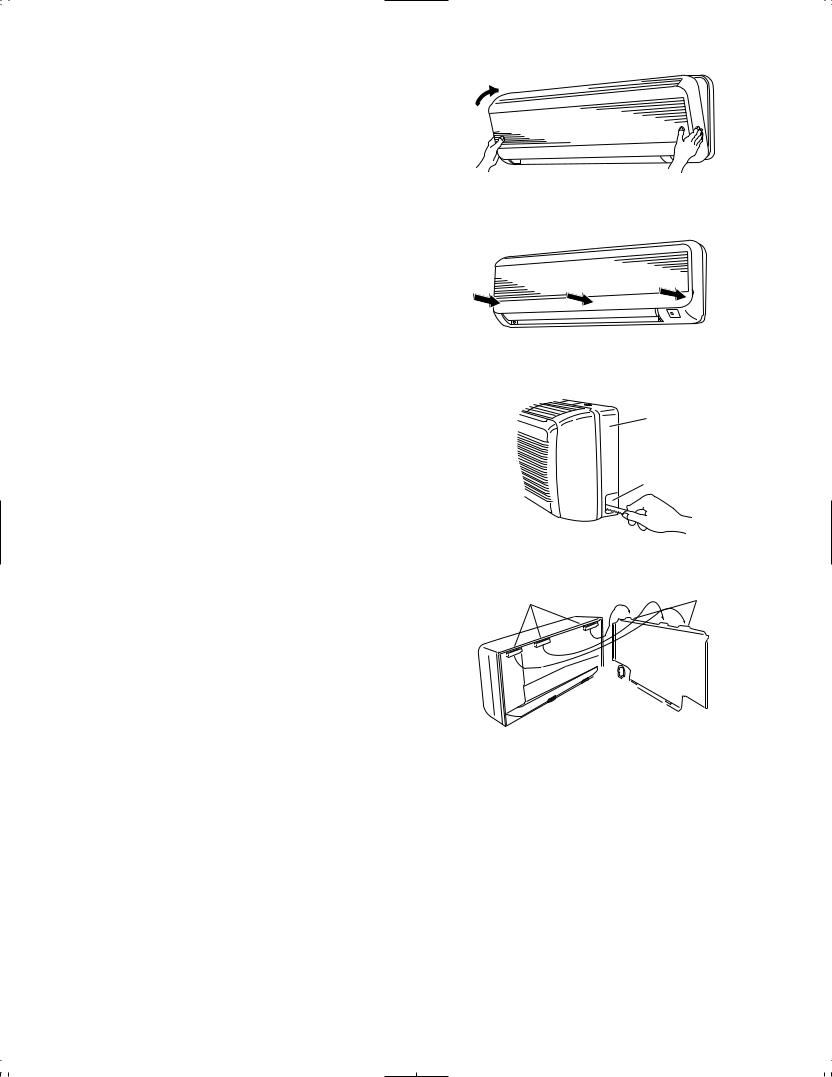
How to replace the grille
(1)Close the flaps.
(2)Reinstall the grille into the lower part while aligning its tabs on the upper part. (Fig. 15a) Insert the tabs in the slots and push the lower part of the grille back into position.
(3)Press at each of the 5 tabs to completely close the grille. Make sure that the grille and frame are firmly fitted together. (Fig. 15b)
3-5. Shape the Indoor Side Tubing
1)Arrangement of tubing by directions
a)Right tubing
The corner of the right frame needs to be cut by a hacksaw or the like. (Fig. 16)
b)Right-rear or left-rear tubing
In this case, the corner of the frame need not be cut.
2)To mount the indoor unit on the rear panel:
Hang the 3 mounting slots of the unit on the upper tabs of the rear panel. (Fig. 17)
3-6. Wiring Instructions
General precautions on wiring
1)Before wiring, confirm the rated voltage of the unit as shown on its nameplate, then carry out the wiring closely following the wiring diagram.
2)Provide a power outlet to be used exclusively for each unit, with a power supply disconnect and circuit breaker for overcurrent protection provided in the exclusive line.
3)To prevent possible hazard due to insulation failure, the unit must be grounded.
4)Each wiring connection must be done tightly and in accordance with the wiring system diagram. Wrong wiring may cause the unit to misoperate or become damaged.
5)Do not allow wiring to touch the refrigerant tubing, compressor, or any moving parts of the fan.
6)Unauthorized changes in the internal wiring can be very dangerous. The manufacturer will accept no responsibility for any damage or misoperation that occurs as a result of such unauthorized changes.
Fig. 15a
Fig. 15b
Frame
Right tubing outlet
Fig. 16
Mounting slot |
Tab |
|
Fig. 17
8
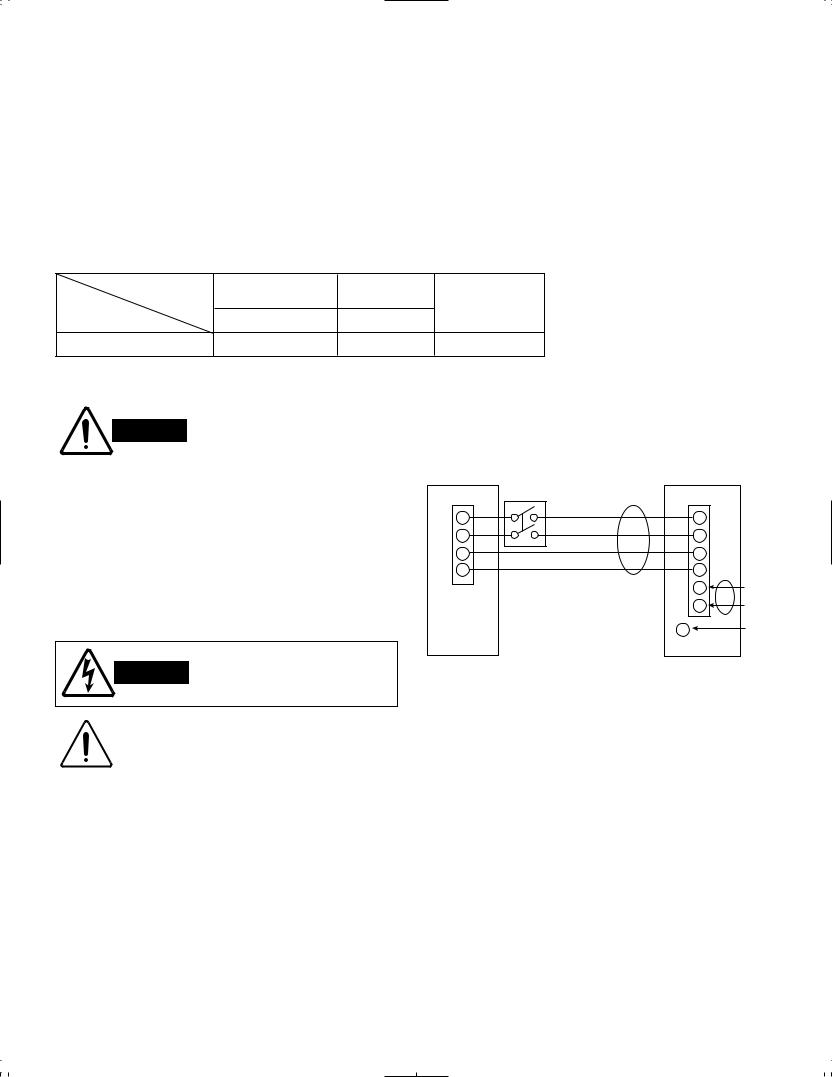
3-7. Recommended Wire Length and Diameter
Regulations on wiring diameter differ from locality to locality. For field wiring requirements, please refer to your local electrical codes. Carefully observe these regulations when carrying out the installation.
Table 5 lists recommended wire lengths and diameters for power supply systems.
Refer to the wiring system diagram (Fig. 18) for the meaning of “A” and “B” in Table 5.
Table 5
AWG |
(A) Power Supply |
(B) Inter-Unit |
Fuse or Circuit |
|
Wiring Length (ft.) |
Power Line |
Capacity |
||
|
||||
Model |
(#12) |
(#14) |
|
|
|
|
|||
C2462R, CL2462R |
64 (Max.) |
132 (Max.) |
35A |
|
|
|
# … AWG (American Wire Gauge) |
||
WARNING |
● Be sure to comply with local |
|
WIRING SYSTEM DIAGRAM |
|
|
||
|
|
|
|
|
|
||
|
codes on running the wire |
INDOOR |
|
|
OUTDOOR |
|
|
|
from the indoor unit to the |
Disconnect |
|
|
|||
|
outdoor unit (size of wire and |
UNIT |
|
UNIT |
|
||
|
switch |
(Inter-unit) |
60HZ |
||||
|
Terminal |
Terminal |
|||||
|
wiring method, etc.). |
Field supply |
|||||
|
power line |
||||||
|
● No wire should be allowed to |
1 |
|
230V/208V |
1 |
|
230V/208V |
|
● Each wire must be firmly |
|
|
|
|
||
|
|
|
230V/208V |
|
|
|
|
|
connected. |
2 |
|
2 |
|
|
|
|
|
|
|
|
|||
|
G |
Grounding line |
|
|
|
||
|
|
G |
|
|
|||
|
|
|
|
|
|
||
|
|
4 |
|
230V/208V |
L1 |
(A) |
supply phase |
|
|
|
(B) |
||||
|
touch refrigerant tubing, the |
|
|
4 |
|
||
|
|
|
|
|
|
|
|
|
compressor, or any moving |
|
|
|
L2 |
|
Power Single- |
|
part. |
|
|
|
|
||
|
|
|
|
|
|
|
|
|
|
|
|
|
G Grounding |
|
|
|
To avoid the risk of electric |
|
|
|
line |
|
|
|
|
|
|
|
|
|
|
WARNING shock, each air conditioner |
|
|
Fig. 18 |
|
|
|
|
|
unit must be grounded. |
|
|
|
|
|
|
|
|
|
|
|
|
|
|
CAUTION |
Be sure to connect the power |
|
supply line to the outdoor unit |
||
|
||
|
||
|
as shown in the wiring dia- |
|
|
gram. The indoor unit draws its |
|
|
power from the outdoor unit. |
9
